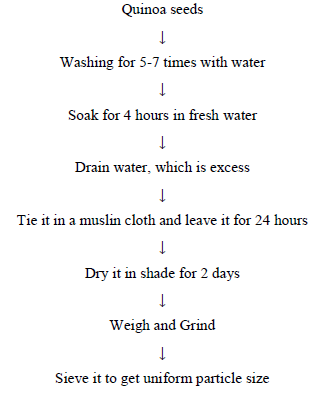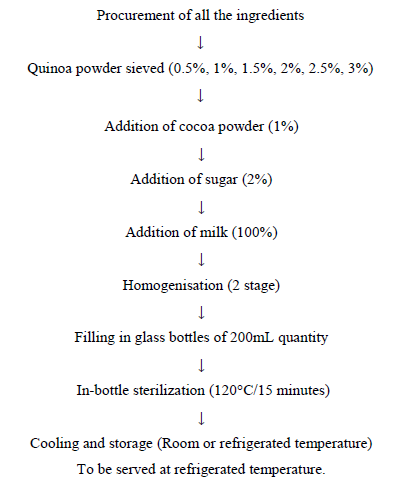Preparation and Sensory Evaluation of Finger Millet Khakhra
Article Information
Pasumarthi Giridhar*
Department of Chemical Engineering, Vignan’s University, Andhra Pradesh, India
*Corresponding Author: Pasumarthi Giridhar, Department of Chemical Engineering, Vignan′s University, Andhra Pradesh, India
Received: 08 March 2019; Accepted: 20 March 2019; Published: 21 March 2019
Citation: Pasumarthi Giridhar. Preparation and Sensory Evaluation of Finger Millet Khakhra. Journal of Food Science and Nutrition Research 2 (2019): 061-064.
View / Download Pdf Share at FacebookAbstract
Khakhra is a crispy version of roti, it is usually a cracker that is handmade and roasted to provide crunchiness. It is also a healthy snack which is a common recipe in the Rajasthani and Gujarati cuisines. Khakhra when prepared by using finger millet as a major ingredient provides a much more nutrition in terms of protein, carbohydrates, minerals and dietary fibers in comparison with the traditional khakhra that is made of wheat flour. Since over consumption of wheat or its products are known for improper health condition such as celiac disorder may overcome by substituting it with ragi or finger millet which is rich in several minerals such as calcium and iron. Finally obtained product is kept for sensory evaluation by using nine point hedonic scale.
Keywords
Finger Millet flour, Sensory Evaluation, Traditional Recipe, Nutritional value
Finger Millet flour articles Finger Millet flour Research articles Finger Millet flour review articles Finger Millet flour PubMed articles Finger Millet flour PubMed Central articles Finger Millet flour 2023 articles Finger Millet flour 2024 articles Finger Millet flour Scopus articles Finger Millet flour impact factor journals Finger Millet flour Scopus journals Finger Millet flour PubMed journals Finger Millet flour medical journals Finger Millet flour free journals Finger Millet flour best journals Finger Millet flour top journals Finger Millet flour free medical journals Finger Millet flour famous journals Finger Millet flour Google Scholar indexed journals Sensory Evaluation articles Sensory Evaluation Research articles Sensory Evaluation review articles Sensory Evaluation PubMed articles Sensory Evaluation PubMed Central articles Sensory Evaluation 2023 articles Sensory Evaluation 2024 articles Sensory Evaluation Scopus articles Sensory Evaluation impact factor journals Sensory Evaluation Scopus journals Sensory Evaluation PubMed journals Sensory Evaluation medical journals Sensory Evaluation free journals Sensory Evaluation best journals Sensory Evaluation top journals Sensory Evaluation free medical journals Sensory Evaluation famous journals Sensory Evaluation Google Scholar indexed journals Traditional Recipe articles Traditional Recipe Research articles Traditional Recipe review articles Traditional Recipe PubMed articles Traditional Recipe PubMed Central articles Traditional Recipe 2023 articles Traditional Recipe 2024 articles Traditional Recipe Scopus articles Traditional Recipe impact factor journals Traditional Recipe Scopus journals Traditional Recipe PubMed journals Traditional Recipe medical journals Traditional Recipe free journals Traditional Recipe best journals Traditional Recipe top journals Traditional Recipe free medical journals Traditional Recipe famous journals Traditional Recipe Google Scholar indexed journals Nutritional value articles Nutritional value Research articles Nutritional value review articles Nutritional value PubMed articles Nutritional value PubMed Central articles Nutritional value 2023 articles Nutritional value 2024 articles Nutritional value Scopus articles Nutritional value impact factor journals Nutritional value Scopus journals Nutritional value PubMed journals Nutritional value medical journals Nutritional value free journals Nutritional value best journals Nutritional value top journals Nutritional value free medical journals Nutritional value famous journals Nutritional value Google Scholar indexed journals dietary fibers articles dietary fibers Research articles dietary fibers review articles dietary fibers PubMed articles dietary fibers PubMed Central articles dietary fibers 2023 articles dietary fibers 2024 articles dietary fibers Scopus articles dietary fibers impact factor journals dietary fibers Scopus journals dietary fibers PubMed journals dietary fibers medical journals dietary fibers free journals dietary fibers best journals dietary fibers top journals dietary fibers free medical journals dietary fibers famous journals dietary fibers Google Scholar indexed journals healthy snack articles healthy snack Research articles healthy snack review articles healthy snack PubMed articles healthy snack PubMed Central articles healthy snack 2023 articles healthy snack 2024 articles healthy snack Scopus articles healthy snack impact factor journals healthy snack Scopus journals healthy snack PubMed journals healthy snack medical journals healthy snack free journals healthy snack best journals healthy snack top journals healthy snack free medical journals healthy snack famous journals healthy snack Google Scholar indexed journals Khakhra articles Khakhra Research articles Khakhra review articles Khakhra PubMed articles Khakhra PubMed Central articles Khakhra 2023 articles Khakhra 2024 articles Khakhra Scopus articles Khakhra impact factor journals Khakhra Scopus journals Khakhra PubMed journals Khakhra medical journals Khakhra free journals Khakhra best journals Khakhra top journals Khakhra free medical journals Khakhra famous journals Khakhra Google Scholar indexed journals grain products articles grain products Research articles grain products review articles grain products PubMed articles grain products PubMed Central articles grain products 2023 articles grain products 2024 articles grain products Scopus articles grain products impact factor journals grain products Scopus journals grain products PubMed journals grain products medical journals grain products free journals grain products best journals grain products top journals grain products free medical journals grain products famous journals grain products Google Scholar indexed journals endemic plant articles endemic plant Research articles endemic plant review articles endemic plant PubMed articles endemic plant PubMed Central articles endemic plant 2023 articles endemic plant 2024 articles endemic plant Scopus articles endemic plant impact factor journals endemic plant Scopus journals endemic plant PubMed journals endemic plant medical journals endemic plant free journals endemic plant best journals endemic plant top journals endemic plant free medical journals endemic plant famous journals endemic plant Google Scholar indexed journals Quinoa malt articles Quinoa malt Research articles Quinoa malt review articles Quinoa malt PubMed articles Quinoa malt PubMed Central articles Quinoa malt 2023 articles Quinoa malt 2024 articles Quinoa malt Scopus articles Quinoa malt impact factor journals Quinoa malt Scopus journals Quinoa malt PubMed journals Quinoa malt medical journals Quinoa malt free journals Quinoa malt best journals Quinoa malt top journals Quinoa malt free medical journals Quinoa malt famous journals Quinoa malt Google Scholar indexed journals
Article Details
1. Introduction
Quinoa (Chenopodium quinoa Wild.) plant belongs to the Chenopodiaceae family, which also includes spinach and beet. There are approximately 250 species of this family all over the world and it is an endemic plant peculiar to South America. The main carbohydrate component of quinoa is starch, and it constitutes 52% to 69% of it. Its total diet fibre is close to that in grain products (7% to 9.7%) while its soluble fibre content is known to be in the 1.3% to 6.1% band. Due to the quality and quantity of its lipid fraction, quinoa is accepted as an alternative oil seed. It has an oil rate of 2.0% to 9.5%, and is rich in terms of essential fatty acids such as linoleic and alpha-linolenic acids. It contains antioxidants like alpha and gamma tocopherol in high concentrations [1-3].
2. Method of Product Manufacture
2.1 Ingredients to be used
- Double toned milk
- Quinoa flour/malt
- Cocoa powder
2.2 Formulation
|
Ingredients |
T0 |
T1 |
T2 |
T3 |
T4 |
T5 |
|
Double toned milk |
100 ml |
100 ml |
100 ml |
100 ml |
100 ml |
100 ml |
|
Quinoa flour/Malt |
0.5 grams |
1 gram |
1.5 grams |
2 grams |
2.5 grams |
3 grams |
|
Cocoa powder |
1 gram |
1 gram |
1 gram |
1 gram |
1 gram |
1 gram |
|
Sweetener |
2 grams |
2 grams |
2 grams |
2 grams |
2 grams |
2 grams |
Table 1: Ingredients.
2.3 Processing of Quinoa flour or malt

Figure 1: Processing of Quinoa flour or malt.
2.4 Flow chart for the preparation of the product

Figure 2: Preparation of Quinoa based RTS dairy beverage.
3. Results and Discussion
Quinoa based RTS dairy beverage from different mixtures of Quinoa powder, Cocoa powder and double toned milk is subjected to sensory evaluation and scores are recorded for different parameters are presented in Table 2 [4-6].
|
Treatments |
Color and Appearance |
Flavour |
Consistency |
Mouth feel |
Overall Acceptability |
|
T0 |
8.33 |
7.8 |
8.35 |
8.01 |
8.12 |
|
T1 |
8.34 |
8.9 |
8.66 |
8.27 |
8.54 |
|
T2 |
8.23 |
8.23 |
8.28 |
8.16 |
8.22 |
|
T3 |
8.18 |
8.20 |
7.21 |
8.04 |
7.91 |
|
T4 |
8.16 |
8.10 |
8.01 |
7.90 |
8.04 |
|
T5 |
8.13 |
7.89 |
7.99 |
7.60 |
7.90 |
Table 2: Sensory evaluation of five Quinoa based RTS dairy beverage.
3.1 Color and appearance
The mean color and appearance score for different treatments of Quinoa based RTS dairy beverage are ranged from 8.1 to 8.34. The treatment T1 (8) is found to be significantly best of the rest of the treatments. It was observed that increase in the level of quinoa flour in the beverage decreases the score of color and appearance slightly (0-5).
3.2 Flavor
It is observed that the mean score for the flavor of Quinoa based RTS dairy beverage for treatments T0, T1, T2, T3, T4 and T5 are 7.8, 8.9, 8.23, 8.20, 8.1 and 7.89 respectively. The treatment T1 is superior of T0 to T5 treatments. It is observed from above findings that 1 gram of Quinoa, 1 gram of cocoa, 2 grams of sugar and 100 ml of milk will give rich taste to the product.
3.3 Consistency
The mean score for the consistency attributes of Quinoa based RTS dairy beverage ranges from 7.21 to 8.66. The treatment T1 (8.66) is significantly best over the rest of the treatments.
3.4 Mouth feel
The highest mouth feel score is observed for treatment T1 (8.27) followed by T2 (8.16), T3 (8.04), T0 (8.01), T4 (7.9) and T5 (7.6). 1-gram Quinoa malt or powder is most acceptable (T1).
3.5 Overall acceptability
The mean score for treatment T0, T1, T2, T3, T4 and T5 are 8.12, 8.54, 8.22, 7.91, 8.04 and 7.90 respectively. The treatment T1 (8.54) is most accepted by the judges. So, use of 1-gram Quinoa malt or powder is most acceptable than the other treatment combinations (0-5) [7-8].
4. Conclusion
Addition of Quinoa malt or powder into milk makes it more nutritious and also helps in improving and increase in the acceptability of milk by many people. The optimum amount of Quinoa malt or powder that can be used in the process of preparation of Quinoa based RTS dairy beverage is up to 1-gram.
References
- Marshall RT. Standard Methods for the determination of Dairy Products. (16th) Publ. American Public Health Association (1992).
- Alvarez-Jubete L, Arendt EK, Gallagher E. Polyphenol composition and in vitro antioxidant activity of amaranth, quinoa buckwheat and wheat as affected by sprouting and baking. Food Chem 119 (2010): 770-778.
- ILCA Manual No.4, Rural Dairy Technology. Experiences from Ethiopia.
- Abugoch James LE. Quinoa (Chenopodium quinoaWilld.): composition, chemistry, nutritional and functional properties. Adv Food Nutr Res 58 (2009): 1-31.
- Comai S. The content of proteic and nonproteic (free and protein-bound) tryptophan in quinoa and cereal flours. Food Chem 100 (2007): 1350-1355.
- Farinazzi-Machado FMV, Barbalho SM, Oshiiwa M, et al. Use of cereal bars with quinoa (Chenopodium quinoa W.) to reduce risk factors related to cardiovascular diseases. Cienc. Technol. Aliment. Campinas 32 (2012): 239-244.
- Sanchez KA. Observations Regarding Consumption of Peruvian Native Grains (Quinoa, Amaranth and Kaniwa), Weight Status, and Perceptions of Potential Risk Factors, Warning Signs and Symptoms of Type 2 Diabetes Among Peruvian Adults: A Case Study. Nutrition and Food Sciences Department (2012).
- Annette McDermott. Quinoa vs. Rice: The Health Benefits of Each Grain. Healthline (2016).
